Barleria soutpansbergensis
Barleria soutpansbergensis I.Darbysh. & K.Balkwill
Family: Acanthaceae
Common names: Soutpansberg bush violet (Eng.); Soutpansberg-bosviooltjie (Afr.)
Introduction
The Soutpansberg bush violet is a newly described species only known from the western Soutpansberg Centre of Plant Endemism, Limpopo Province, where it grows in rock crevices in dry open woodland, giving a burst of pale blue flowers in late summer. A spectacular addition to a sunny water-wise garden.
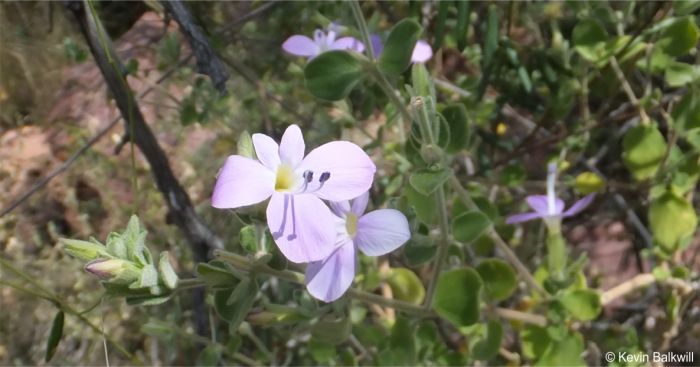
Description
Description
Barleria soutpansbergensis is a non-spiny, much branched, herbaceous perennial or shrub growing up to 1 m high. Leaves are small, elliptic, 9–27 x 6.5–16.5 mm, shortly stalked, green, covered with grey hairs and with smooth margins. Stems are hairy, green, turning sandy brown and woody with age. Inflorescence is a single-flowered cyme that is borne in the axils at the tips of branches. Flower petals are pale blue to mauve, rarely white, and yellow inside, 20–34 mm long, covered with short hairs. The flowers have 2 long stamens (male reproductive parts consisting of anthers and filaments) that are slightly hairy at the base, and a stigma (female part) that also protrudes far out of the flower. The fruit is a 4-seeded capsule, 11–13.5mm long, green, slightly hairy, dry when mature, becoming brown and woody and exploding to release 4 brown to black seeds. B. soutpansbergensis flowers from mid-summer to autumn (February to April). Seeds can be harvested from autumn to winter (May to June).

Barleria soutpansbergensis looks similar to B. obtusa, they have a similar growth habit, leaves and both lack spines, however, the two can be easily identified based on the size and form of their flowers. B. soutpansbergensis petals are unequal, the upper lobes are shorter than the lower lobes when compared to B. obtusa whose upper lobes are longer than the lower lobes. Another distinguishing factor is that the inner petals of B. soutpansbergensis are yellow while the inner petals of B. obtusa are blue with white stripes. No populations of B. obtusa have been observed to occur in the Soutpansberg, it is thus safe to conclude that the two species are allopatric – they do not occur in the same geographical area.
Conservation Status
Status
Although the population is known from one locality, Barleria soutpansbergensis is assessed as Least Concern (LC) according to Darbyshire & Balkwill, as no threats have been identified and some collectors have noted the species to be locally common within its restricted range.
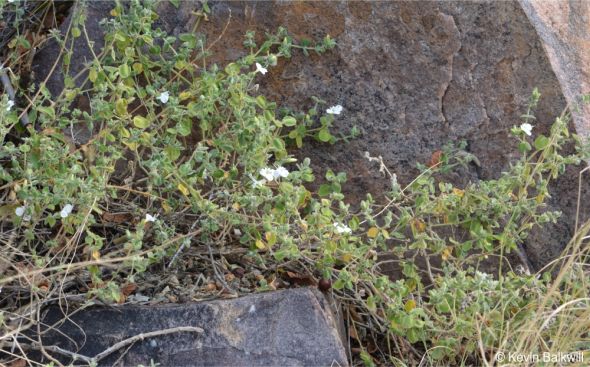
Distribution and habitat
Distribution description
Barleria soutpansbergensis is only known from the Soutpansberg and parts of Blouberg, Limpopo Province, where it thrives in rocky and sandy areas with full sun, tolerates light frost and receives average summer rainfall. In its natural habitat, the Soutpansberg bush violet experiences hot summers and survives throughout winter without rain but frequent morning fog.
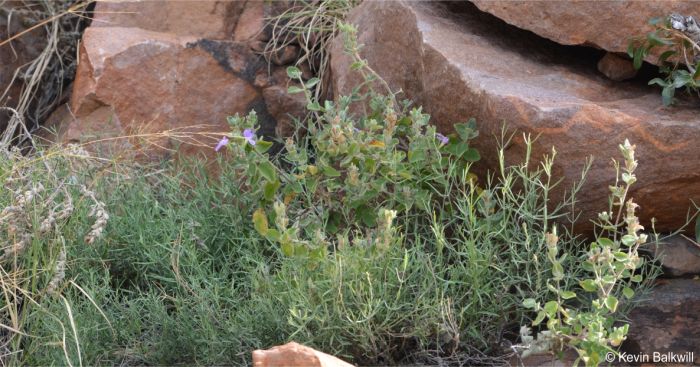
Derivation of name and historical aspects
History
The genus Barleria belongs to the Acanthaceae, a family consisting of about 191 genera and 4 900 species. Southern African members of the Acanthaceae family are found mostly growing in dry conditions, however, some thrive in moist forests. The genus Barleria was first described by Carl Linnaeus, the father of taxonomy, who named it after a Dominican monk and Botanist Jacques Barelier (1606–1673). Barleria is one of the largest genera in the family comprising of about 300 species widespread in tropical and subtropical areas of the world such as southern Africa, Asia and India. Approximately 60 species naturally occur in southern Africa.
This species is named for the Soutpansberg, a mountain range where it naturally occurs. The name Soutpansberg, formerly Zoutpansberg meaning ‘salt pan mountain’ in Afrikaans and Thavha ya muno in Venda, is a mountain range covering about 6 700km² in the Vhembe district of Limpopo Province that stretches from a small town of Vivo to Kruger National Park, near Pafuri gate. The N1 road traffic passes the Soutpansberg, through Hendrik Verwoerd Tunnel from Makhado to Beit Bridge border post between South Africa and Zimbabwe.
Soutpansberg is one of the 18 Centres of Plant Endemism in southern Africa and has the highest plant diversity, boasting of rare and threatened plant species that are of cultural value and medicinal use. The Soutpansberg forms part of the Vhembe Biosphere Reserve, declared as a Biosphere Reserve by UNESCO in 2009, which includes the Blouberg mountain range, Mapungubwe Cultural Landscape and Kruger National Park. The spectacular mountain range comprises a fusion of biomes ranging from south-east facing Afromontane forest, thicket, grassland found on southern slopes, fynbos-type vegetation growing mainly on the highest point of the mountain mist belt and fosters about 3 000 flowering plants of which 45, including the newly described B. soutpansbergensis, are endemic to the area and more new, highly range restricted species are yet to be discovered and described (Kevin Balkwill, pers. comm).
Barleria soutpansbergensis was first collected in the 1930s and known as a novelty to the taxonomy community but was only officially described in 2022 by Dr. Ian Darbyshire, Professor Kevin Balkwill and Willem Froneman.
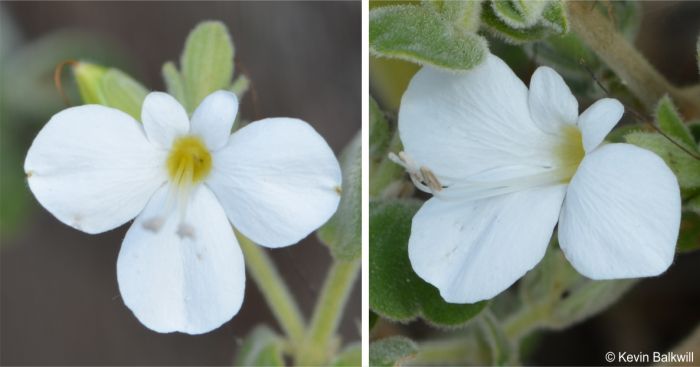
Ecology
Ecology
Soutpansberg bush violet is pollinated by insects and attracts nectar-hunting moths, flying from one flower to another at night resulting in pollination. Barleria soutpansbergensis flowers in late summer (February to April) and fruits start developing in autumn, from mid-April, dry and burst open to release seeds in winter, from mid to late May. Seeds are dispersed by a phenomenon known as ballistic seed dispersal, where the capsule bursts open and shoots the seeds out with some force.
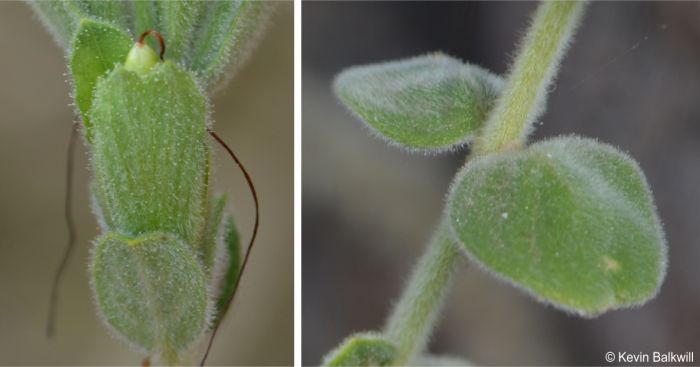
Uses
Use
No cultural uses or applications have been documented for this species. The irregularly shaped flowers, hairy leaves and bushy growth form suggest horticultural potential. Soutpansberg bush violet could be used in a rocky, water-wise garden or as a pot plant, in hanging baskets, in full sun. According to a 2018 study, some Barleria species roots and leaves are used medicinally by traditional herbalists in India to cure ailments such as anemia, cough, skin diseases, body aches, toothache and inflammation, however no medicinal usage of Barleria soutpansbergensis has been recorded.
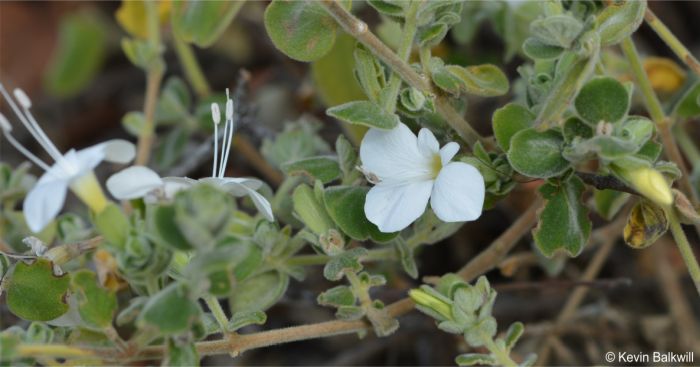
Growing Barleria soutpansbergensis
Grow
Barleria soutpansbergensis has not yet been cultivated in the Thohoyandou National Botanical Garden and there is no propagation record from literature, however, in its natural habitat, B. soutpansbergensis grows in rock crevices, in well drained sandy soil, exposed to full sunlight and will be ideal for a rocky garden with well-drained soil and warm regions that experience hot summers, warm winters and light frost.
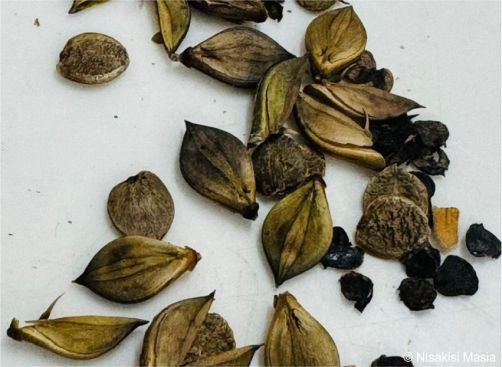
Barlerias can easily be propagated either from seeds and vegetatively from cuttings. Collect seeds as soon as the capsules become hard and turn brown, avoid waiting for longer periods to harvest as the capsules burst open to release seeds on the ground. Sow seeds in mixture of 1 part clean sifted river sand and 1 part sifted potting soil and place in a warm area with filtered sunlight. Water twice weekly. Germination should be noticeable within 14 days. Transplant the seedlings into medium seedling bags filled with a mixture of 1 part river sand and 2 parts potting soil, water twice a week for 3 weeks before planting directly into the garden.
Softwood and semi-hardwood cuttings work best for Barleria species. Take 120 mm long cuttings in early summer in the morning, before the parent plants show signs of wilting from heat. Treat with growth hormone to encourage rooting. Plant them in a mixture of 1 part coarse river sand and 2 parts potting soil, space them 5 cm apart for optimal growth and rooting. Place them in a warm area with less sunlight exposure, and water twice a week. Rooting takes place within 3 weeks. Transplant rooted seedlings into medium seedling bags and pots or plant directly into your well-drained rock garden in full sun.
There are no specific pests or diseases that affect Barleria soutpansbergensis. Barleria species are mostly fertilized with a high phosphorus liquid fertilizer once every two weeks in spring and summer. High phosphorus content in fertilizers encourage root development.
References
- Darbyshire, I., Balkwill, K. & Froneman, W. 2022. Two new species of Barleria (Acanthaceae) from the Soutpansberg of Limpopo Province, South Africa. Kew Bulletin 77:475–489.
- Endangered Wildlife Trust. Secrets of the Soutpansberg. https://ewt.org.za/Secrets-of-the-Soutpansberg. Accessed 14/08/2024.
- Hahn, N. 2017. Endemic flora of the Soutpansberg, Blouberg and Makgabeng. South African Journal of Botany 113: 324-336.
- Darbyshire, I., et al. 2019. Phylogenetic relationships among species of Barleria (Acanthaceae, Lamiales): Molecular data reveal complex patterns of morphological evolution and support a revised classification. Taxon 68: 92–111.
- Kumar, J.U.S., Chaitanya M.J.K., Semotiuk, A.J. & Krishna, V. 2019. Indigenous knowledge of medicinal plants used by ethnic communities of South India. Journal of Ethnobotany Research and Applications 18:1–112.
- Mahendra, C.P. 2018. Ethnomedicinal uses of plant Barleria of family Acanthaceae. International Journal of Applied Research 4(1): 493-495.
- Manzitto-Tripp, E.A., Darbyshire, I., Daniel, T.F., Kiel, C.A. & Mcdade, L.A. 2021. Revised classification of Acanthaceae and worldwide dichotomous keys. Taxon 71:103–153.
Credits
Ntsakisi Masia
Millennium Seed Bank Partnership, Thohoyandou
September 2024
Acknowledgements: the author extends gratitude to Professor Kevin Balkwill and Willem Froneman for images and species information.
Plant Attributes:
Plant Type: Perennial, Shrub
SA Distribution: Limpopo
Soil type: Sandy, Loam
Flowering season: Late Summer, Autumn
PH: Acid, Neutral
Flower colour: Blue, White, Mauve/Lilac
Aspect: Full Sun, Morning Sun (Semi Shade), Afternoon Sun (Semi Shade)
Gardening skill: Easy
Special Features:
Horticultural zones







Rate this article
Article well written and informative
Rate this plant
Is this an interesting plant?
Login to add your Comment
Back to topNot registered yet? Click here to register.